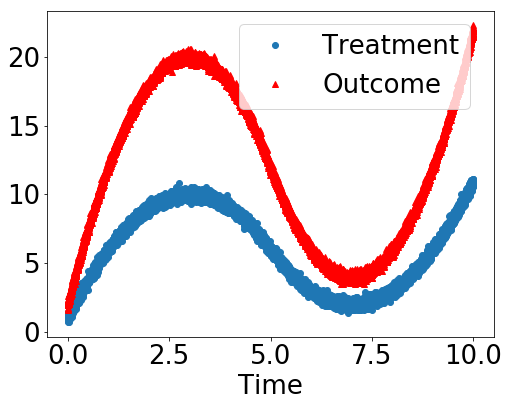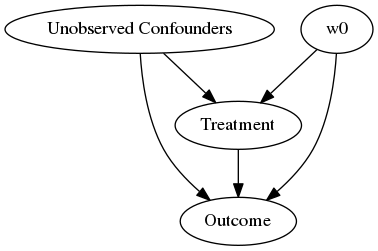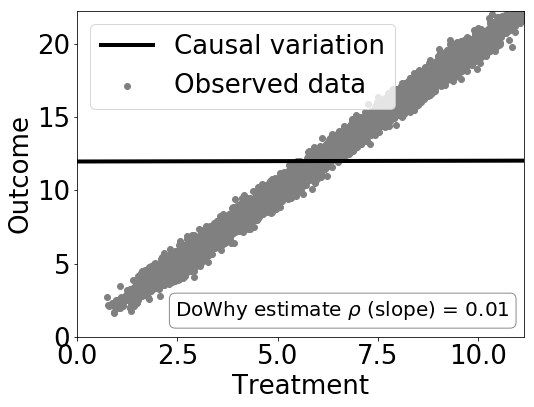Confounding Example: Finding causal effects from observed data
Suppose you are given some data with treatment and outcome. Can you determine whether the treatment causes the outcome, or the correlation is purely due to another common cause?
[1]:
import os, sys
sys.path.append(os.path.abspath("../../"))
[2]:
import numpy as np
import pandas as pd
import matplotlib.pyplot as plt
import seaborn as sns
import math
import dowhy
from dowhy.do_why import CausalModel
import dowhy.datasets, dowhy.plotter
Let’s create a mystery dataset for which we need to determine whether there is a causal effect.
Creating the dataset. It is generated from either one of two models: * Model 1: Treatment does cause outcome. * Model 2: Treatment does not cause outcome. All observed correlation is due to a common cause.
[3]:
rvar = 1 if np.random.uniform() >0.5 else 0
data_dict = dowhy.datasets.xy_dataset(10000, effect=rvar, sd_error=0.2)
df = data_dict['df']
print(df[["Treatment", "Outcome", "w0"]].head())
Treatment Outcome w0
0 9.226765 17.942530 3.064244
1 5.627733 11.675522 -0.379016
2 9.593378 19.594728 3.692605
3 6.347941 12.917889 0.480172
4 2.806808 5.247733 -3.304526
[4]:
dowhy.plotter.plot_treatment_outcome(df[data_dict["treatment_name"]], df[data_dict["outcome_name"]],
df[data_dict["time_val"]])

Using DoWhy to resolve the mystery: Does Treatment cause Outcome?
STEP 1: Model the problem as a causal graph
Initializing the causal model.
[5]:
model= CausalModel(
data=df,
treatment=data_dict["treatment_name"],
outcome=data_dict["outcome_name"],
common_causes=data_dict["common_causes_names"],
instruments=data_dict["instrument_names"])
model.view_model(layout="dot")
WARNING:dowhy.do_why:Causal Graph not provided. DoWhy will construct a graph based on data inputs.
INFO:dowhy.do_why:Model to find the causal effect of treatment ['Treatment'] on outcome ['Outcome']
Showing the causal model stored in the local file “causal_model.png”
[6]:
from IPython.display import Image, display
display(Image(filename="causal_model.png"))

STEP 2: Identify causal effect using properties of the formal causal graph
Identify the causal effect using properties of the causal graph.
[7]:
identified_estimand = model.identify_effect()
print(identified_estimand)
INFO:dowhy.causal_identifier:Common causes of treatment and outcome:['w0', 'U']
WARNING:dowhy.causal_identifier:There are unobserved common causes. Causal effect cannot be identified.
WARN: Do you want to continue by ignoring these unobserved confounders? [y/n] y
INFO:dowhy.causal_identifier:Instrumental variables for treatment and outcome:[]
Estimand type: ate
### Estimand : 1
Estimand name: backdoor
Estimand expression:
d
──────────(Expectation(Outcome|w0))
dTreatment
Estimand assumption 1, Unconfoundedness: If U→Treatment and U→Outcome then P(Outcome|Treatment,w0,U) = P(Outcome|Treatment,w0)
### Estimand : 2
Estimand name: iv
No such variable found!
STEP 3: Estimate the causal effect
Once we have identified the estimand, we can use any statistical method to estimate the causal effect.
Let’s use Linear Regression for simplicity.
[8]:
estimate = model.estimate_effect(identified_estimand,
method_name="backdoor.linear_regression")
print("Causal Estimate is " + str(estimate.value))
# Plot Slope of line between treamtent and outcome =causal effect
dowhy.plotter.plot_causal_effect(estimate, df[data_dict["treatment_name"]], df[data_dict["outcome_name"]])
INFO:dowhy.causal_estimator:INFO: Using Linear Regression Estimator
INFO:dowhy.causal_estimator:b: Outcome~Treatment+w0
Treatment
Causal Estimate is 0.0051827863049

Checking if the estimate is correct
[9]:
print("DoWhy estimate is " + str(estimate.value))
print ("Actual true causal effect was {0}".format(rvar))
DoWhy estimate is 0.0051827863049
Actual true causal effect was 0
Step 4: Refuting the estimate
We can also refute the estimate to check its robustness to assumptions (aka sensitivity analysis, but on steroids).
Adding a random common cause variable
[10]:
res_random=model.refute_estimate(identified_estimand, estimate, method_name="random_common_cause")
print(res_random)
INFO:dowhy.causal_estimator:INFO: Using Linear Regression Estimator
INFO:dowhy.causal_estimator:b: Outcome~Treatment+w0+w_random
['Treatment']
Treatment
Refute: Add a Random Common Cause
Estimated effect:(0.0051827863049019127,)
New effect:(0.0052748828365418695,)
Replacing treatment with a random (placebo) variable
[11]:
res_placebo=model.refute_estimate(identified_estimand, estimate,
method_name="placebo_treatment_refuter", placebo_type="permute")
print(res_placebo)
INFO:dowhy.causal_estimator:INFO: Using Linear Regression Estimator
INFO:dowhy.causal_estimator:b: Outcome~placebo+w0
['Treatment']
placebo
Refute: Use a Placebo Treatment
Estimated effect:(0.0051827863049019127,)
New effect:(0.0013214086372636913,)
Removing a random subset of the data
[12]:
res_subset=model.refute_estimate(identified_estimand, estimate,
method_name="data_subset_refuter", subset_fraction=0.9)
print(res_subset)
INFO:dowhy.causal_estimator:INFO: Using Linear Regression Estimator
INFO:dowhy.causal_estimator:b: Outcome~Treatment+w0
['Treatment']
Treatment
*** Causal Estimate ***
## Target estimand
Estimand type: ate
### Estimand : 1
Estimand name: backdoor
Estimand expression:
d
──────────(Expectation(Outcome|w0))
dTreatment
Estimand assumption 1, Unconfoundedness: If U→Treatment and U→Outcome then P(Outcome|Treatment,w0,U) = P(Outcome|Treatment,w0)
### Estimand : 2
Estimand name: iv
No such variable found!
## Realized estimand
b: Outcome~Treatment+w0
## Estimate
Value: 0.0032596514859678217
Refute: Use a subset of data
Estimated effect:(0.0051827863049019127,)
New effect:(0.0032596514859678217,)
As you can see, our causal estimator is robust to simple refutations.